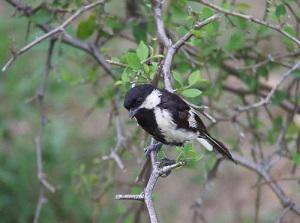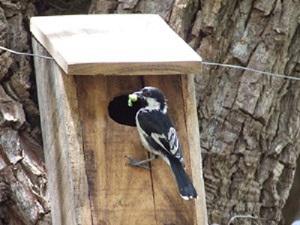Himani Kala
Other projects
11 Mar 2010
Conservation of the White-Naped Tit and its Thorn Forest Habitat in the Southern Aravalli Hill Range
This project involves developing model fodder plots in the villages dependent on the habitat of White-naped Tit, with the community participation, so that pressure is reduced and the species and its habitat is conserved.

Fragmentation of thorn forest habitat due to various anthropogenic activities such as cutting, lopping, quarrying, encroachment for agriculture, grazing and conversion of thorn forest led to habitat loss and degradation adding natural pressure in terms of intra-specific competition for food and nesting sites for White-naped Tit. This chain of pressures has its origin from the local communities residing in the vicinity of its habitat, who are mostly dependent on this forest for their fuel-wood and fodder needs. This study aims at restoring and improving the natural resource availability in and around the village environs with active participation of the locals. Awareness on resource use and sustainable management would be done in all villages neighbouring highly degraded habitats with WNT. However, habitat improvement and improving natural resource availability would be done in a couple of villages as a pilot effort to create a model.

The restoration of the highly needed natural resources i.e. fuel-wood and fodder, in and around the village environs through developing fodder and fuel-wood plots to meet out the immediate and future requirement of fodder, fuel wood, and small timber for house construction. The resource needs, extraction and species preferred would be documented after focus group discussion with the villagers in addition to getting them involved in restoring their common and grazing lands for their better livelihood. The awareness creation on its management in terms of maintenance, security, harvest and sharing along with significance of sustainable use and the conservation of the adjoining forest would be the best means of conserving the WNT and its threatened thorn forest habitat. This would be followed by taking up pilot restoration as part of habitat improvement for the WNT in the thorn forest adjoining the villages selected for natural resources development, with the active participation of the managers and the local communities. The proposed project will not only seek to conserve this endemic species but will also present a compelling argument among different stake holders including local communities and forest managers to develop their basic resources in their own vicinity. This would serve as a model for conservation of this threatened species in the distribution range of the Species.

The major activities involve assessment of Resource Use/Extraction, preparation of Resource Availability and Use Maps, Habitat Improvement and Development of Fuel-wood and Fodder plot and Awareness and Education.